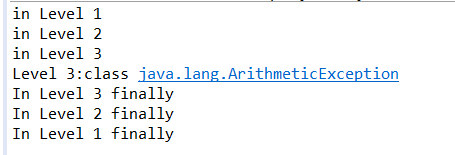1.实例
1 import javax.swing.*; 2 3 class AboutException { 4 public static void main(String[] a) 5 { 6 int i=1, j=0, k; 7 k=i/j; 8 9 10 try 11 { 12 13 k = i/j; // Causes division-by-zero exception 14 //throw new Exception("Hello.Exception!"); 15 } 16 17 catch ( ArithmeticException e) 18 { 19 System.out.println("被0除. "+ e.getMessage()); 20 } 21 22 catch (Exception e) 23 { 24 if (e instanceof ArithmeticException) 25 System.out.println("被0除"); 26 else 27 { 28 System.out.println(e.getMessage()); 29 30 } 31 } 32 33 34 finally 35 { 36 JOptionPane.showConfirmDialog(null,"OK"); 37 } 38 39 } 40 }
2.基础知识
(1)Java中的异常捕获语句:
-
Try{
-
//可能发生运行错误的代码;
-
}
-
catch(异常类型 异常对象引用){
-
//用于处理异常的代码
-
}
-
finally{
-
//用于“善后” 的代码
-
}
(2)使用Java异常处理机制
-
把可能会发生错误的代码放进try语句块中。
-
当程序检测到出现了一个错误时会抛出一个异常对象。异常处理代码会捕获并处理这个错误。 catch语句块中的代码用于处理错误。
-
当异常发生时,程序控制流程由try语句块跳转到catch语句块。
-
不管是否有异常发生,finally语句块中的语句始终保证被执行。
-
如果没有提供合适的异常处理代码,JVM将会结束掉整个应用程序。
3.多层的异常捕获
1 public class CatchWho 2 { 3 public static void main(String[] args) 4 { 5 try 6 { 7 try 8 { 9 throw new ArrayIndexOutOfBoundsException(); 10 } 11 catch(ArrayIndexOutOfBoundsException e) 12 { 13 System.out.println( "ArrayIndexOutOfBoundsException" + "/内层try-catch"); 14 } 15 16 throw new ArithmeticException(); 17 } 18 catch(ArithmeticException e) 19 { 20 System.out.println("发生ArithmeticException"); 21 } 22 catch(ArrayIndexOutOfBoundsException e) 23 { 24 System.out.println( "ArrayIndexOutOfBoundsException" + "/外层try-catch"); 25 } 26 } 27 }

1 public class CatchWho2 2 { 3 public static void main(String[] args) 4 { 5 try 6 { 7 try 8 { 9 throw new ArrayIndexOutOfBoundsException(); 10 } 11 catch(ArithmeticException e) 12 { 13 System.out.println( "ArrayIndexOutOfBoundsException" + "/内层try-catch"); 14 } 15 throw new ArithmeticException(); 16 } 17 catch(ArithmeticException e) { 18 19 System.out.println("发生ArithmeticException"); 20 } 21 catch(ArrayIndexOutOfBoundsException e) 22 { 23 System.out.println( "ArrayIndexOutOfBoundsException" + "/外层try-catch"); 24 } 25 } 26 }

1 public class EmbededFinally 2 { 3 4 5 public static void main(String args[]) 6 { 7 8 int result; 9 10 try 11 { 12 13 System.out.println("in Level 1"); 14 15 16 try 17 { 18 19 System.out.println("in Level 2"); 20 // result=100/0; //Level 2 21 22 try 23 { 24 25 System.out.println("in Level 3"); 26 27 result=100/0; //Level 3 28 29 } 30 31 catch (Exception e) 32 { 33 34 System.out.println("Level 3:" + e.getClass().toString()); 35 36 } 37 38 39 finally 40 { 41 42 System.out.println("In Level 3 finally"); 43 44 } 45 46 47 // result=100/0; //Level 2 48 49 50 } 51 52 catch (Exception e) 53 { 54 55 System.out.println("Level 2:" + e.getClass().toString()); 56 57 } 58 finally 59 { 60 61 System.out.println("In Level 2 finally"); 62 63 } 64 65 // result = 100 / 0; //level 1 66 67 } 68 69 catch (Exception e) 70 { 71 72 System.out.println("Level 1:" + e.getClass().toString()); 73 74 } 75 76 finally 77 { 78 79 . System.out.println("In Level 1 finally"); 80 81 } 82 } 83 }

1 public class EmbededFinally 2 { 3 4 5 public static void main(String args[]) 6 { 7 8 int result; 9 10 try 11 { 12 13 System.out.println("in Level 1"); 14 15 16 try 17 { 18 19 System.out.println("in Level 2"); 20 result=100/0; //Level 2 21 22 try 23 { 24 25 System.out.println("in Level 3"); 26 27 result=100/0; //Level 3 28 29 } 30 31 catch (Exception e) 32 { 33 34 System.out.println("Level 3:" + e.getClass().toString()); 35 36 } 37 38 39 finally 40 { 41 42 System.out.println("In Level 3 finally"); 43 44 } 45 46 47 // result=100/0; //Level 2 48 49 50 } 51 52 catch (Exception e) 53 { 54 55 System.out.println("Level 2:" + e.getClass().toString()); 56 57 } 58 finally 59 { 60 61 System.out.println("In Level 2 finally"); 62 63 } 64 65 result = 100 / 0; //level 1 66 67 } 68 69 catch (Exception e) 70 { 71 72 System.out.println("Level 1:" + e.getClass().toString()); 73 74 } 75 76 finally 77 { 78 79 System.out.println("In Level 1 finally"); 80 81 } 82 83 } 84 85 }

结论:Java通过使用try…catch…finally语句来捕获一个或多个异常,catch语句可以有一个或多个,而且至少要一个catch语句或finally。当有多层嵌套的finally时,异常在不同的层次抛出 ,在不同的位置抛出,可能会导致不同的finally语句块执行顺序。如果某处发生异常,则try语句中此处之后的代码都不会被执行。
4.实例
1 public class SystemExitAndFinally 2 { 3 4 5 public static void main(String[] args) 6 7 { 8 9 try 10 { 11 12 13 System.out.println("in main"); 14 15 throw new Exception("Exception is thrown in main"); 16 17 //System.exit(0); 18 19 20 } 21 22 catch(Exception e) 23 24 { 25 26 System.out.println(e.getMessage()); 27 28 System.exit(0); 29 30 } 31 32 finally 33 34 { 35 36 System.out.println("in finally"); 37 38 } 39 40 } 41 42 43 }

结论:
-
与finally相对应的try语句得到执行的情况下,finally才有可能执行。 -
finally执行前,程序或线程终止,finally不会执行。